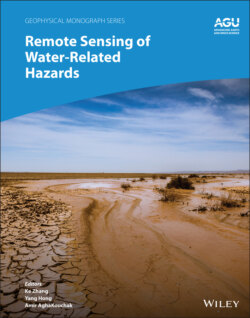Читать книгу Remote Sensing of Water-Related Hazards - Группа авторов - Страница 34
2.4.4. Applicability of IMERG in Flash Flood Warning
ОглавлениеIn this section, three types of rainfall products are used, including the IMERG Early run (IMERG‐E), IMERG Final run (IMERG‐F), and China Meteorological Administration hourly data (CMA). The three products are accumulated to 1 h, 3 h, 6 h, and 24 h, respectively, and then the RTI method is employed to calculate the corresponding effective accumulated rainfall. At the same time, combining the frequency of flash floods and the atlas of rainstorm statistical parameters, the multiperiod critical precipitation of 1 h, 3 h, 6 h, and 24 h (hereinafter referred to as CR1, CR3, CR6, CR24) is obtained. Then, we construct a G(x) warning model for each effective cumulative rainfall (Rt) and critical rainfall (CRt). Since this model does not consider many potential influencing factors, such as vegetation, underlying surface, etc., flash flood risk distribution maps should also be considered when issuing flash flood warnings. Integrating the flash flood risk map obtained by Ma et al. (2019), Figures 2.10 and 2.11 show the flood warning results. For specific products and finer time scales, flooding events are more detectable.
For a specific product, the detectability of flash flood events is better for finer temporal scale. The hit rate of CR6 and CR24 is lower, less than 60%. Most of the flash flood events captured by these three precipitation products are located in western Yunnan, while in the relatively flat southwest and central Yunnan, there are fewer flash flood outbreaks. In general, if a flash flood event cannot be captured in a short period, it will not be captured at a lower time scale. Compared with IMERG‐F, IMERG‐E is significantly worse at capturing flood events; IMERG‐E’s hit rate is lower than 50% on all time scales. Conversely, IMERG‐F showed considerable accuracy in capturing CR1 and CR3 of the CMA flood, with a difference of 1%. For instance, the hit rate of IMERG‐F for CR1 is about 80%. But the hit rate decreases significantly as the time scale decreases from 1h to 24h.
Figure 2.10 The performance of the flash floods captured by the three products (IMERG‐F, IMERG‐E, CMA) for different times (1 h, 3 h, 6 h, 24 h). Red indicates that the warning issued has captured the flash flood event; blue indicates that the issued warning has not captured the flash flood event.
Source: Based on Ma et al. (2020).
Figure 2.11 Percentage of flash floods caught by CMA, IMERG‐E, and IMERG‐F, based on Ma et al. (2020). Note: CRt represents the critical rainfall at time t.
Source: Based on Ma et al. (2020).
According to the accuracy in capturing flood events, CMA is better than IMERG‐F, followed by IMERG‐E. However, another important issue is the latency of those products. CMA is a merged product based on CMORPH and ground station data and thus has a nonnegligible latency time. IMERG‐F has a latency time of more than one month. IMERG‐E has a latency time of several hours. Currently, many studies use near‐real‐time satellite products such as IMERG‐E to monitor flood hazards. However, operational flood forecasting must rely on nowcast precipitation from weather models. Therefore, how to make those products useful in practical application is still challenging.
